
|
Sale 48
Pre-Long Beach Coin Auction
| The Ohringer Collection PT II - $10 Gold - Gold Bar |
| |
| |
| Lot |
Photo |
Description |
Realized |
Lot 1318 |
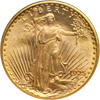 |
1925-D $20 St. Gaudens. NGC graded MS-65. In NGC holder 1812921-001. A brilliant untoned gem, well struck and sparkling with frosty mint luster. A few stray contact marks here and there, none of which are too serious.
Like the 1924-D $20, the 1925-D had its rarity ranking revised since the mid-20th century by the emergence of a few small hoards overseas. While both dates are similar in rarity, the edge in high grades such as this dazzling MS65 goes to the 1925-D. We have offered only a few Gems over the years, and there is no need to remind bidders that a Mint State 65 example appearing at auction is an event. Typically well impressed for the issue, the main devices rise sharply above the fields with solid overall definition. The luster is frosty throughout, the surfaces bathed (dare we say "refreshed") by original pinkish gold color, very pretty, extremely attractive. A tiny mark is seen on Liberty's forward leg just below the knee; this is the only worthwhile provenance marker to use, along with the aforementioned grading holder serial number. The spectacular surfaces are far nicer than average for this numerical grade, as the photographs clearly show.
Regarded unemotionally, without fear of contradiction, we can honestly say that to find another incredible beautiful gem like this, especially at the visual level this coin supplies the viewer, is an undertaking not to be sneezed at. Liberty glides effortlessly forth from a rich sun-drenched aura into the bright golden dawn while the eagle's plumage on the reverse shows even its tiniest detail. The mintage of 2.9 million pieces sometimes fools collectors into think this year isn't all that rare; however, it fails to take into consideration the fact that most of these were stored in bank vaults or at the various Treasury buildings and Federal Reserve Banks in the late 1920s and early 1930s. During the gold recall of 1933-34, nearly all the issue was put behind locked doors and later transferred to deep storage at the newly built Fort Knox (1937) in the form of "coin melt" bars. In the latter half of the 1930s, millions of double eagles were melted into bars. Indeed, the 1925-D double eagle was once thought of as a major rarity by collectors. It still is very scarce, and incredibly rare in Gem condition. It may be that only a few have been brought back from Europe in the 1960s and 1970s. The present Gem gets our nod (and NGC's stamp of approval) for physical originality and attractiveness. It belongs in a world-class collection. Pop 7; 1 finer in 66 (PCGS # 9181) .
Estimated Value $90,000 - 100,000.
View details and enlarged photos
Check results on similar lots
| Unsold |
Lot 1319 |
 |
1927-S $20 St. Gaudens. NGC graded MS-66. In NGC holder 1911240-002. Frosty and well struck. As is the case with many branch mint dates in the Saint-Gaudens series from the 1920s and early 1930s, the 1927-S had considerable prestige despite its mintage. Slightly over three million were struck in the San Francisco mint in this year. (Almost the entire mintage was melted in the 1930s.) In the 1940s, the 1927-S was considered by collectors to be one of the Big Four in terms of rarity.
Since that time, a relatively few auction appearances of low-end Mint State grade 1927-S double eagles occur since this is one of the more widely appreciated S-mint rarities of the period. Turnover of "estate" and "name" sales was barely sufficient to supply the increasing demand. Most of these, again, were low-end, generally bagmarked specimens. Near-Gem to Gem quality examples turn out to be incredibly rare. Originally thought to be even rarer than the legendary 1927-D, came the 1950s, and that perception changed when a few pieces turned up in European bank hoards. But like the 1926-D, the 1927-S never occurs in any quantity. Very few are auctioned today in all grades, and it is always an occasion when we have one to offer. The smart, sparkling golden luster flares into heavy frostiness in a few areas with magnificent hues and smooth flow into all the crevices. Such, then, for luster. Turning to the other key factor: a coin that is desirable with this meticulous strike on the figure and face of Liberty, the sun rays and the small Capitol dome by her side. The eagle, for its part, continues the sharp relief into the wings, flight feathers, and all of the breast detail, with few grade-activating marks to draw your critical attention to. All in all a landmark offering of this important rarity. Pop 4; 2 finer in 67 (PCGS # 9188) .
Estimated Value $150,000 - 185,000.
View details and enlarged photos
Check results on similar lots
| Realized
$161,000 |
Lot 1320 |
 |
1929 $20 St. Gaudens. PCGS graded MS-65. Well struck and intensely lustrous bursting with brilliant golden hues. Luster this dominant is sure to attract a lot of attention to its fresh golden frostiness. In this way, from first to last, the luster glows. Furthermore, from top to bottom as it were, from the highest points on the design to the wide open spaces, the strike is as keen as any seen on a 1929 rarity. Liberty has a full nose and complete other facial expression free from scuffs; complete drapery folds in her billowing dress; the eagle displays complete breast feathers (a detail that is often contentious on some dates, but fortunately not 1929). In short, a razor-sharp coin. The lucky bidder will never feel that he has been stung by some pungent mistake when he leaves the sale as the new owner. Far from any chastisement, those in the know will realize and recognize that the coin in some ways outclasses an even higher grade specimen. Pop 22; 5 in 66 (PCGS # 9190) .
Gold note: First noticeable in Germany in late 1928, and slowly developing a head of steam like some fast accelerating locomotive, the world's money managers began to withdraw gold coins from the banks of Europe, England and the United States as the stock market crash and developing business depression started to bite. Coins like the $20 gold piece in America formed the basis of the monetary system over here under the Gold Standard. By 1930, but especially in the troubling years 1931 to 1935, vast amounts of American gold in the form of coins as well as bullion bars, were withdrawn from the banking system and shipped overseas. That is why so few circulated dates from 1928 to 1933 exist in this series; they never, in fact, made it into circulation. Many (most?) were later melted.
Estimated Value $75,000 - 80,000.
View details and enlarged photos
Check results on similar lots
| Realized
$77,625 |
Lot 1321 |
 |
1930-S $20 St. Gaudens. PCGS graded MS-65. Well struck and delicately toned. The lovely natural golden toning on both sides improves the already expansive beauty of this Gem quality example. A very rare late date Saint-Gaudens double eagle. The production run was a mere 74,000, serving to give an explanation to the low supply of coins to be had by collectors. Always difficult to obtain. There do not appear to be many abrasions that would bar this frosty double eagle from its lock-solid MS65 designation by the grading service. It is really quite spectacular! Since it is a full-bore Gem we see no need to persuade one and all to prepare a strict market price. There will be no slipping through the cracks with this one when it comes up for bidding. Besides the coin's smooth features, both sides show a precision strike that conforms well with what we know about other 1930-S $20 gold pieces, that this date was more carefully produced than other S-mint twenties in the Saint-Gaudens series. Identical to other issues in the late 1920s and early 1930s, this year was a heavily melted one. In the vein of the 1929, 1931, 1931-D, and 1932 from the standpoint of total number of coins known, the number saved was severely reduced after the great gold confiscation by the Federal government in 1933 (approximately $2.8 billion in gold valued at the then $20.67 per ounce fixed price).
As an MS65, the 1930-S is an extremely rare coin with very few pieces having been so graded by the major services. Of the highest order of rarity, this piece will be certain to spawn much interest at lot viewing and the price it finally realizes at the sale could be a revelation to many. Pop 8; 5 in 66 (PCGS # 9191) .
Estimated Value $170,000 - 190,000.
View details and enlarged photos
Check results on similar lots
| Unsold |
Lot 1322 |
 |
1931 $20 St. Gaudens. PCGS graded MS-66. Lovely rich golden toning. Well struck. A popular rare date. Since virtually the entire collector holdings for 1931 falls into the Mint State range, observation tells us that this date never reached general circulation. Most of the 2,938,250 pieces originally minted were melted by the government and today the 1931 is comparable in overall rarity to the equally respected 1932.
Among Saint-Gaudens pieces, the 1931 is considered as one of the top seven rarities in the series. Note that the population statistics by the grading services can sometimes be misleading since the same coin may have been submitted to both services at different times, or to the same service multiple times thus affecting the published figures. Be that as it may, only a few better-quality specimens have been auctioned in recent years, with this handsome MS66 among the most eye-catching and beautiful, the very sort of coin to handle the situation when numerous bidders show up at an auction hankering to bid. Pop 9; 1 finer in 67 (PCGS # 9192) .
Estimated Value $100,000 - 125,000.
View details and enlarged photos
Check results on similar lots
| Unsold |
Lot 1323 |
 |
1931-D $20 St. Gaudens. PCGS graded MS-65. A gorgeous well struck gem exhibiting full mint bloom color. One of the finest graded of the date, and a rarity in all grades. Breen estimated two decades ago in his Encyclopedia that only 30-35 survived, but this number appears low to us now, since the combined NGC and PCGS Population Reports show more than 120 pieces graded in all grades. All the same, the coin presented is clearly one of the better specimens known, this lustrous gem boasts bright gold luster around the periphery, enhanced by pleasing light rose shades in towards the centers. Minor handling marks but nothing to keep this from the rock-solid gem class it is in, as a strong glass will reveal. An opportunity for the advanced numismatist.
The rarity of the 1931-D should be readily evident after Akers referred to a group of fifteen to twenty examples that surfaced in the mid 1980s. While the coins in that "hoard" were sufficient to knock the 1931-D out of the same rarity class as the vaunted 1930-S, most of these graded no better than Choice MS63. Often the various grading services overshoot in their estimates or undershoot, but on this particular occasion they must have had their 20-20 spectacles focused, which resulted in their shooting squarely at the bull's eye and hitting it dead on target. A strong, quibble-free MS65, in other words. This leaves gemmier specimens like the one offered here as better condition rarities. The present naturally toned 1931-D $20 gold piece is among the most attractive of the late date issues we have offered in recent sales, primarily due to its spectacular aesthetic appeal! Pop 18; 3 in 66 (PCGS # 9193) .
Estimated Value $110,000 - 120,000.
View details and enlarged photos
Check results on similar lots
| Unsold |
Lot 1324 |
 |
1915-S Panama-Pacific Gold $50 Round. PCGS graded MS-65 PQ. A wonderful example. Well struck. Only 483 pieces minted. As nice an example we have ever seen.
The Pan-Pac $50 round is one of the most incredible coins ever conceived and offered for sale; it is replete with symbolism, though the symbolic connotations are lost on most numismatists. Stuck at the edge of America's involvement in the European "Great War," the Greek helmet is lifted back on Minerva's head in a ready but not fully combative pose, similar to the helmeted head seen on the famous Corinthian staters of ancient times featuring Pegasus the flying horse. The owl on the reverse signifies watchfulness. This is a resolutely gorgeous Gem example, then, and one of the few full MS65s we think deserves a "Premium Quality listing. When was the last time you dreamed of owning a solid Gem $50 Round of this type. Now is your chance. The surface is immaculate, which is only to be expected. The luster envelops all areas with a smooth, bright, satiny embrace. This coin has clearly been well preserved since the day it was sold to a fortunate collector back in nineteen-and-fifteen. Extremely desirable in such Gem condition. Pop 9; none finer at PCGS (PCGS # 7451) .
Estimated Value $110,000 - 120,000.
View details and enlarged photos
Check results on similar lots
| Realized
$172,500 |
Lot 1325 |
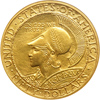 |
1915-S Panama-Pacific Gold $50 Round. NGC graded MS-65. A brilliant untoned satiny mint gem and a perfect match with the Octagonal example. Only 483 minted.
In 1915, visitors from all over the world converged on a veritable new city that had been built of lath and plaster on the San Francisco shore front. Following upon the tradition established by the 1876 Centennial Exhibition (Philadelphia), 1892-1893 World's Columbian Exposition (Chicago), the 1900 Paris Exposition, the 1904 St. Louis World's Fair, and other events, the Panama-Pacific International Exposition showcased marvels of technology, art, history, and science.
After the event ended, nearly everything was torn down. An exception was the Palace of Fine Arts, which, while never intended to be a permanent structure, survived to be used to store fire engines and other municipal equipment. In recent times it has been restored. This building in 1915 housed the numismatic exhibit of the Exposition. Under its huge dome was Farran Zerbe's Money of the World display and, after the fair's closing, his concession to sell the remaining Panama-Pacific coins by mail order.
America's fairs and expos usually revolve around a theme. For 1915, the fair organizers honored the discovery of the Pacific Ocean (1513) and the aforementioned completion of the Panama Canal (1914) as the dual anchor points for their theme. A series of 5 coins was struck for the occasion, including complete sets mounted in metal frames or leather cases sold for $200. Many sales were made to banks and other novices; for this reason, high grade examples, especially of the two $50 gold denominations, are a challenge to find. The larger the denomination, the harder to locate. Some were also carried as souvenir pieces, in fact. When all was said and done, only 483 Round $50 gold pieces were sold. And it can be assumed (though no separate records were kept in this regard) that numerous specimens in the hands of the public were melted after the federal government seized America's gold coins in 1933. We estimate there are 200 or so of the round $50 pieces remaining.
Today the five different coins issued in connection with the Panama-Pacific International Exposition stand as the high-water mark of American commemoratives. The $50 round is legendary in U.S. federal coinage, both for its size ($50 or two and one-half ounces of 900 Fine gold) and dimensions. The artistry was by Robert Aitken, noted sculptor and coin designer whose handiwork presents Minerva, goddess of the harvest, wearing a Corinthian plumed helmet. Aitken used a more down-home emblem for his reverse, a "wise" owl perched upon a pine branch. Curiously, the wisdom of owls is much overrated. According to the trainers who worked the various owls in the Harry Potter series of movies, owls are little more than flying sharks -- sophisticated eating machines with only enough brains to get along with. They're downright unfriendly and almost impossible to train to do tricks. Nevertheless, Minerva's owl is golden and beautiful, and we'll stick with the proverbial "wise", on this foremost of all U.S. commemorative gold pieces! What a spectacular way to preserve the occasion than by this well struck, satin-gem Mint State 65 certified by America's top-tier grading firm, NGC (Numismatic Guarantee Corporation). Pop 45; 19 in 66, 3 in 67 (PCGS # 7451) .
Estimated Value $100,000 - 110,000.
Ex Prinzi Collection.
View details and enlarged photos
Check results on similar lots
| Realized
$120,750 |
Lot 1326 |
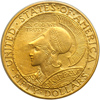 |
1915-S Panama-Pacific Gold $50 Round. PCGS graded MS-64. Delicate sunset golden and pale olive toning further adds to its eye appeal. In an old green label holder. Only 483 minted.
The goddess Minerva or Athena wears the crested helmet found on numerous depictions of her in ancient Greek coinage; it is pushed back off her face, to signify peaceful intentions. According to the Breen-Swiatek history of these important $50 coins, "We have not found the exact Greek coin used as prototype of this head, though the crested helmet is of the Athenian type, and there are numerous silver coins of Velia and Corinth showing her in this type of helmet, sometimes wreathed as here, often with other devices on it. Most such types have a long tailpiece to the crest, which is omitted here." On her shield is MCMXV (1915), only the second use of Roman numerals for date in United States coinage history up to that time (the first was the various types of Saint-Gaudens double eagles of 1907). Why Athena or Minerva? She was the goddess of wisdom, skill, agriculture, horticulture, spinning and weaving, crop rotation, among other things, and she taught her followers to grow and use olives, whose oil was long indispensable in cooking and providing light by night. All these were important in early California. Pop 80; 9 in 65 (PCGS # 7451) .
Estimated Value $65,000 - 70,000.
View details and enlarged photos
Check results on similar lots
| Realized
$100,625 |
Lot 1327 |
 |
1915-S Panama-Pacific Gold $50 Octagonal. PCGS graded MS-65 PQ. In PCGS holder 09748404. Nice light golden toning and boldly struck. Very choice for the grade. Only 645 pieces minted. The Mint Act of January 16, 1915 authorized a fifty dollar gold piece along with a gold $1, a gold quarter eagle, and a silver half dollar to commemorate the Panama-Pacific International Exposition scheduled to open in San Francisco that year. Proceeds from sale of these commemorative coins would help defray the cost of exposition. Several events were being commemorated, including the opening of the Panama Canal in 1914.
Both $50 gold pieces were the handiwork of Robert Aitken. Since many of them were purchased by wealthy individuals where were not necessarily coin collectors, it stands to reason a fair number of them were slightly handled (or even mishandled) by their owners or heirs. With this in mind, is it any wonder why so few Gems of the octagonal motif survive today? A significant number were cleaned. This lovely Premium Quality Gem is a perfect match for the Round $50 gold in this sale with the same grade. The coin displays beautiful soft golden color and radiates a pure satiny luster. No observable blemishes are noted, making this an impressive Gem specimen for the well-heeled numismatist; one of the most remarkable issues in the U.S. Commemorative series. Pop 17; 1 finer in 66 (PCGS # 7452) .
Estimated Value $100,000 - 110,000.
View details and enlarged photos
Check results on similar lots
| Realized
$161,000 |
Lot 1328 |
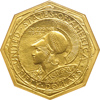 |
1915-S Panama-Pacific Gold $50 Octagonal. NGC graded MS-65. A brilliant untoned satiny mint gem and a perfect match with the Round example. Only 645 minted. This shapely super-star of American numismatics has an obvious tie-in to California's gold rush private issues with the same 8-sided format of the Territorial "Slugs" of yesteryear. The Octagonal $50 Pan-Pacific coin was sold in slightly greater numbers than the round format of similar design (645 versus 483 pieces). The enormous two-and-one-half ounce octagonal piece differs by the addition of dolphins around the margin to fill in what might otherwise be empty areas inside the rims. The dolphins were a symbol of the Panama Canal opening ceremonies that took place the year prior to this coin's release. Even under close scrutiny, this Gem Mint State 65 piece appears to be worthy of its illustrious grade rating. Even with close detection does not one come across abrasions or obvious hairlines, with the portrait of Minerva (Minerva -- known also as Pallas Athena in Greek mythology -- was a Roman goddess) stately and serene in its beauty. Desirable this lustrous with vivid color. Pop 40; 6 in 66, 4 in 67. (PCGS # 7452) .
Estimated Value $90,000 - 100,000.
View details and enlarged photos
Check results on similar lots
| Realized
$126,500 |
Lot 1329 |
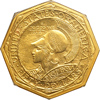 |
1915-S Panama-Pacific Gold $50 Octagonal. PCGS graded MS-64. A very choice brilliant untoned specimen, boldly struck on the key devices and showing the stylized leafy motif of a wreath on Minerva's helmet (a high point on the design). Only 645 minted.
During preparations for the Panama-Pacific Exposition's opening, the Philadelphia Mint shipped a 14-ton hydraulic press to the fairgrounds for the specific purpose of striking the $50 gold pieces.
On June 15, 1915, the first octagonal pieces were struck. During the months of June, July and August, the remaining gold fifties were coined. According to Arlie Slabaugh, after the first 62 round fifties were coined, the dies broke in striking the 63rd -- as did the remaining pairs of dies then on hand. Coinage had to be delayed until more dies arrived from Philadelphia.
The authorizing act specified 3,000 fifties: 1,500 each of the octagonal and round types. Sales went well enough to convince the authorities to strike the entire authorization, with 9 extras reserved for assay of the octagonal type, 10 extras of the round. However, the high prices of these coins severely limited the numbers to be sold. According to Exposition price lists, a single $50 coin could be had for $100, but this price entitled the buyer to the half dollar, dollar and quarter eagle free of additional charge. Pop 116; 17 in 65, 1 in 66. (PCGS # 7452) .
Estimated Value $65,000 - 70,000.
View details and enlarged photos
Check results on similar lots
| Realized
$92,000 |
Lot 1330 |
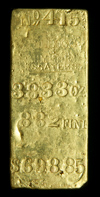 |
(1857). Kellogg & Humbert gold bar No. 415. 38.33 oz. 882 Fine gold, value at time of issue $698.85. A wonderful gold treasure bar and a very desirable example from these assayers of the California Gold Rush era. The bar itself is a deep yellow gold in color with lustrous surfaces. The lower right corner has been chipped off for assay purposes, a feature on all genuine gold bars of the era. Also we note the control number of the bar No. 415 is also stamped on the back of the bar. This particular bar is plated in Q. David Bowers A California Gold Rush History.
This bar is accompanied by the special leather edition of Q. David Bowers A California Gold Rush History and the new owner will doubtles spend many hours discussing the epic tales of the discovery of gold in California, and the tragedy of the loss of life on the Central America wreck. Truly a fantastic historical relic which will be the center-piece of a gold coin collection. The bar is encased in a custom plastic holder and a modern made Kellogg & Humbert Assayers wooden strong box with lock-up key made for display purposes is also included.
Estimated Value $100,000 - 110,000.
View details and enlarged photos
| Realized
$115,000 |
|
|